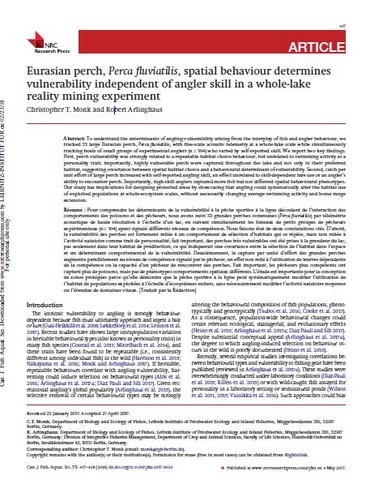To understand the determinants of angling vulnerability arising from the interplay of fish and angler behaviour, we tracked 33 large Eurasian perch, Perca fluviatilis, with fine-scale acoustic telemetry at a whole-lake scale while simultaneously tracking boats of small groups of experimental anglers (n = 104) who varied by self-reported skill. We report two key findings. First, perch vulnerability was strongly related to a repeatable habitat choice behaviour, but unrelated to swimming activity as a personality trait; importantly, highly vulnerable perch were captured throughout the lake and not only in their preferred habitat, suggesting covariance between spatial habitat choice and a behavioural determinant of vulnerability. Second, catch per unit effort of large perch increased with self-reported angling skill, an effect unrelated to skill-dependent lure use or an angler’s ability to encounter perch. Importantly, high-skill anglers captured more fish but not different spatial behavioural phenotypes. Our study has implications for designing protected areas by showcasing that angling could systematically alter the habitat use of exploited populations at whole-ecosystem scales, without necessarily changing average swimming activity and home range extension.
Eurasian perch, Perca fluviatilis, spatial behaviour determines vulnerability independent of angler skill in a whole-lake reality mining experiment
Peer-reviewed

Monk, C. T., Arlinghaus, R. (2018). Eurasian perch, Perca fluviatilis, spatial behaviour determines vulnerability independent of angler skill in a whole-lake reality mining experiment. Canadian Journal of Fisheries and Aquatic Sciences, 75, 417-428
Published
: 2018
Appeared in
: Canadian Journal of Fisheries and Aquatic Sciences, 75, 417-428
